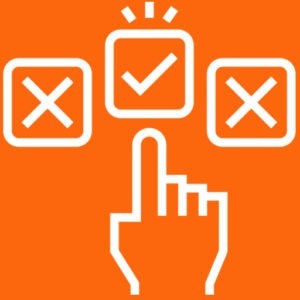Like it or not, Business ERP systems are notoriously complicated. Unnecessarily complicated. My father, the greatest salesman in my opinion, used to call it, “an amorphous mass of undo-ability.”
Complication causes confusion, and some software companies fail to recognize that efficiency isn’t just a buzzword—it’s a lifeline for your business. As your business grows, the complexity of operations can become overwhelming. Enter the ERP (Enterprise Resource Planning) system, sometimes just called CRM, a unified software solution designed to streamline and automate business processes. But what exactly should a small business look for in an ERP system? It’s not what you think!
Business ERP Feature 1: Invoicing and Link to Pay
Accounting is the Heartbeat of Business, and getting paid is the blood
Jude Campbell CEO of Selling Lane

ERP systems are often seen as complex and expensive, but they can be a valuable tool for businesses of all sizes. Here are the five pillars of business ERP, explained in a nutshell:
The Power of Efficient Invoice and Payment Processing
The way businesses handle invoices and payments can significantly impact their success. Efficient invoice and payment processing is more than just a back-office function; it’s a critical component that can influence customer satisfaction, cash flow, and the overall health of a business. Here’s a deeper dive into its importance:
- Streamlined Cash Flow: Efficient invoicing ensures that businesses send out accurate bills promptly. When combined with a smooth payment processing system, it ensures quicker payments, reducing the time between delivering a service and getting paid. This timely inflow of cash is vital for maintaining a healthy cash flow.
- Enhanced Customer Experience: Nobody likes to deal with complicated invoices or cumbersome payment methods. A clear, concise invoice and a straightforward payment process can enhance the customer experience. It reduces confusion, minimizes the chances of disputes, and ensures that customers can settle their bills with ease.
- Reduced Administrative Burden: Automated and efficient systems reduce the manual effort involved in generating invoices, tracking them, and processing payments. This not only saves time but also minimizes the chances of human errors, which can lead to costly mistakes or disputes.
- Real-time Reporting and Analytics: Modern invoicing and payment processing systems often come with analytics tools. Businesses can get real-time insights into their financials, track pending payments, and forecast cash flow, enabling them to make informed decisions.
- Security: With the rise in cyber threats, the security of financial transactions is paramount. Efficient payment processing systems prioritize security, ensuring that customer data is protected and transactions are secure. This not only safeguards the business but also builds trust with customers.
- Flexibility and Multiple Payment Options: Today’s customers expect multiple payment options, be it credit cards, digital wallets, bank transfers, or even cryptocurrencies. An efficient system can accommodate these varied methods, offering flexibility to customers and ensuring that businesses don’t miss out on sales due to payment constraints.
- Environmental and Cost Benefits: Digital invoicing and payment processing are not only efficient but also eco-friendly. By reducing the need for paper invoices, businesses can cut down on costs and contribute to environmental conservation.
- Improved Vendor and Supplier Relations: Just as businesses invoice their customers, they also receive invoices from vendors and suppliers. An efficient payment processing system ensures that these invoices are paid on time, fostering trust and building strong business relationships.
- Scalability: As businesses grow, the volume of invoices and payments can increase exponentially. An efficient system can scale with the business, ensuring that the increased volume doesn’t lead to inefficiencies or bottlenecks.
- Regulatory Compliance: With financial transactions come regulatory requirements. Efficient systems ensure that businesses remain compliant, be it in terms of taxes, financial reporting, or adhering to payment standards.
In the grand scheme of business operations, invoice and payment processing might seem like mundane tasks. However, their efficiency and effectiveness can have ripple effects throughout a business. By prioritizing these processes, businesses can ensure smooth operations, satisfied customers, and robust financial health.
Business ERP Feature 2: Customer Relationship Management (CRM)
The purpose of a business is to create a customer who creates customers.
Shiv Singh

In today’s hyper-connected world, where choices abound, and brand loyalty is fickle, understanding and managing customer relationships isn’t just important—it’s the bedrock of sustainable business growth. The age-old adage, “The customer is king,” has never been truer. But how do businesses ensure that the king remains loyal to their kingdom?
Enter the CRM (Customer Relationship Management) module, a vital component of any comprehensive Enterprise Resource Planning (ERP) system. Here’s a deeper dive into the transformative power of a well-implemented CRM:
- Tracking Customer Interactions: Every touchpoint, whether it’s a casual inquiry, a sales call, or post-purchase feedback, is an opportunity to understand your customer better. A CRM system meticulously logs these interactions, ensuring that no detail, however minute, is overlooked.
- Lead Management: In the sales funnel, leads are potential gold mines. But not all leads are created equal. A CRM helps in segmenting and prioritizing these leads, ensuring that efforts are directed where they’re most likely to yield results.
- Ensuring Timely Follow-ups: Timing is often the difference between a lead turning cold and a successful conversion. Automated reminders and follow-up schedules ensure that you’re always a step ahead, reaching out to potential clients at the optimal moment.
- Building Long-term Relationships: A CRM isn’t just about making a sale; it’s about building a relationship. By understanding customer preferences, purchase histories, and feedback, businesses can tailor their offerings, making clients feel valued and understood.
- Data-driven Insights: With a plethora of data at their fingertips, businesses can derive actionable insights. Which marketing campaign worked best? Which product is a hit in a particular demographic? A CRM provides answers, guiding future strategies.
ERP Feature 3: Menu Selling System
Why a Menu Selling System Simplifies Decision-Making for Buyers

The way products or services are presented can make all the difference. Enter the menu selling system – a structured approach that not only streamlines the sales process but also simplifies decision-making for buyers. Here are the top reasons why:
- Clear Presentation of Options: Unlike traditional selling where options can be overwhelming, a menu selling system lays out choices in a clear, organized manner. This clarity reduces confusion and helps buyers understand their options better.
- Tiered Choices: Often, menu selling presents products or services in tiers, allowing buyers to quickly gauge what’s basic, intermediate, or premium. This tiered approach helps buyers align their choices with their budget and needs.
- Reduced Overwhelm: By presenting a curated set of options, menu selling prevents information overload. Buyers aren’t bombarded with too many choices, making the decision process less daunting.
- Transparent Pricing: With each option or tier, the pricing is clearly indicated. This transparency ensures there are no hidden costs, and buyers can make informed decisions based on their financial considerations.
- Faster Decision-Making: Since options are clearly laid out and easy to compare, buyers can make decisions faster. They don’t need to sift through heaps of information or ask numerous questions to understand what’s on offer.
- Builds Trust: A straightforward, transparent menu selling system can enhance trust. Buyers appreciate knowing that they’re getting a fair deal without the typical sales runaround.
- Facilitates Upselling: With a clear view of what each tier or option offers, buyers can easily see the value in higher-tiered products or services, making them more receptive to upsells.
- Personalized Experience: Many menu selling systems allow for customization. Buyers can start with a base option and add on specific features or services they want, leading to a more personalized buying experience.
- Consistency in Sales: For businesses, menu selling ensures that every customer gets a consistent sales pitch. This consistency can enhance the brand’s reputation and ensure that all customers are aware of the full range of options available.
- Educates the Buyer: A well-structured menu selling system can also serve as an educational tool, informing buyers about products or services they might not have been aware of.
In conclusion, a menu selling system isn’t just a tool for businesses to enhance their sales process; it’s a strategy that respects and empowers the buyer. By simplifying choices, providing transparency, and facilitating a more personalized buying experience, menu selling turns the often-dreaded decision-making process into a smooth, enjoyable journey.
ERP Feature 4: GTD Style Task Management
The key is not to prioritize what’s on your schedule, but to schedule your priorities.
Stephen Covey
Enterprise Resource Planning (ERP) systems are designed to integrate and streamline various business processes across an organization. While they traditionally focused on core functions like finance, HR, and manufacturing, many times they forget the importance of task management. Here’s why task management is an indispensable component of a modern Business ERP system:
- Unified Workflow: Business ERP systems aim to create a seamless flow of information across departments. By integrating task management, businesses can ensure that tasks related to various functions, from procurement to customer service, are aligned, tracked, and executed efficiently.
- Enhanced Productivity: With a centralized task management system, employees can prioritize their tasks, set deadlines, and allocate resources more effectively. This reduces the time spent on manual coordination and boosts overall productivity.
- Real-time Monitoring: Integrated task management allows managers and team leaders to monitor task progress in real-time. They can quickly identify bottlenecks, reassign tasks if necessary, and ensure that projects stay on track.
- Improved Collaboration: In large organizations, tasks often require input from multiple departments. An Business ERP system with task management facilitates cross-departmental collaboration by providing a platform where teams can share updates, documents, and feedback.
- Resource Optimization: By having a clear view of all tasks and their requirements, businesses can allocate resources more effectively. This ensures that no team is overburdened while others are underutilized.
- Data-Driven Decision-Making: Integrated task management provides valuable data on task completion rates, team performance, and project timelines. This data can inform strategic decisions, helping businesses optimize processes and improve efficiency.
- Reduced Errors: Manual task management can lead to oversights and errors. By automating and integrating this function into an ERP system, businesses can reduce the chances of tasks being overlooked or duplicated.
- Enhanced Customer Service: With streamlined task management, customer-related tasks such as order processing, service requests, and complaint resolution can be handled more swiftly. This leads to improved customer satisfaction.
- Scalability: As businesses grow, the volume and complexity of tasks can increase. An Business ERP system with integrated task management can easily scale to accommodate this growth, ensuring that the business continues to operate smoothly.
- Holistic View: One of the primary benefits of an ERP system is that it provides a holistic view of business operations. By including task management, businesses can gain insights into the granular day-to-day tasks that, in aggregate, drive the company’s success.
Remember, effective task management is not just about ticking off tasks from a list; it’s about ensuring that the tasks you’re focusing on are the ones that move you closer to your goals.
While ERP systems offer a broad range of functionalities, the inclusion of task management is pivotal. It not only ensures the smooth execution of daily operations but also provides insights and tools that can drive a business’s strategic growth. In today’s competitive landscape, where agility and efficiency are paramount, task management within an ERP system is not just an add-on; it’s a necessity.
Business ERP Feature 5: Business Website Builder.
Building a website is laying the cornerstone of your digital empire.
Chris Ducker
Combining your business website with your main software makes everything run smoother and offers great perks. Here are five reasons why they should be together
- All in One Place: Having your website and Business ERP together means all your business info is in one spot. No more jumping between systems to get things done.
- Better for Customers: When everything’s connected, customers can see up-to-date product info, track their orders, and manage their accounts easily. It’s all about making things smooth for them.
- Faster Order Handling: Orders from your website go straight into your system, making the whole process of selling and shipping quicker and less complicated.
- Easy-to-See Business Info: With everything in one system, you can quickly see how your business is doing, from website visits to sales numbers.
- Saves Money: Instead of paying for and managing two separate systems (one for your website and one for everything else), you have everything together, which is simpler and more cost-effective.
In short, combining your website with your ERP system makes running your business smoother, better for your customers, and can save you money. It’s like having a Swiss Army knife for your business needs!
Final Thoughts: The Power of Integration
An Business ERP system isn’t just about individual components; it’s about how they seamlessly integrate to offer a holistic view of your business operations. For small businesses, this integration is the key to agility, adaptability, and growth. With the right ERP system, like Selling Lane’s comprehensive suite, small businesses are not just surviving—they’re thriving.
Remember, in the world of business, standing still is moving backward. Equip your business with the tools it needs to move forward, faster.






